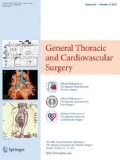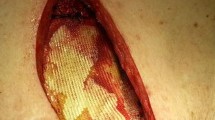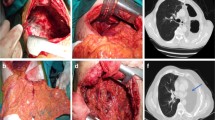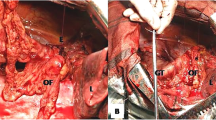Abstract
Plombage methods were designed for treating pulmonary tuberculosis surgically around 1945 when pulmonary tuberculosis was regarded as a “traitor disease” in Japan. Nagaishi had reported extrapleural synthetic resin ball plombage in 1948 as the world’s first case, but it was complicated by empyema due to perforation of cavities and rupture of lesions because the resin ball was hard. Later, fillers were improved by using soft material. At the present time, only air plombage and omentoplasty remain. Especially the latter has gained widespread use in the thoracic surgery field and become a standard procedure. Chronic empyema with bronchopleural fistula sometime requires surgical treatment despite the development of various antibiotics, but highly stressful surgery that can cause reduced pulmonary function or thoracic deformity must be avoided. Therefore, one-stage omentoplasty utilizing such omental multifunctions as hose action, angiogenesis, sucker action, and the immune reaction has been found to have clinical significance for thoracic empyema and its complications. This method is described in detail.
Similar content being viewed by others
References
Nagaishi C, Tsuji S, Minokuchi G. Extrapleural plombage methode with synthetic resin ball. Kekkaku Kenkyuu 1947;3:31.
Nagaishi C, Tsuji S, Minokuchi G. Extrapleural resin ball plombage. Kyobu Geka 1948;1:25–27.
Armada O, O’Brien WB, Vindzberg WV, Wilson NJ. Extraperiosteal plombage thoracoplasty: operative technique and results with 161 cases with unilateral surgical problems. J Thorac Surg 1956;32:797–813; discussion, 813–9.
Nagaishi C, Hirakawa K, Yamashita M. Extrapleural plombage with elastic soft absorbable synthetic polyvinyl formal: especially its technique. Nihon Kekkaku 1955;14:188.
Chamberlain JM, Storey CF, Klopstock R, Daniels CF. Segmental resection for pulmonary tuberculosis; 300 cases. J Thorac Surg 1953;26:471–485.
Pate JW, Hughes FA Jr, Campbell RE, Reisser JM. Air plombage with resection for pulmonary tuberculosis; a technique for decreasing complications. J Thorac Surg 1959;37:435–441.
Iioka S. Surgical management of chronic empyema: clinical result of one-stage operation, “Kinchu method.” Nippon Kyobu Geka Gakkai Zasshi 1982;30:1672–1683
Iioka S, Sawamura K, Nagaoka Y, Chikamori J, Mori T, Nanjo S, et al. A new surgical method for chronic empyema: application of the extraperiosteal “air-plombage” procedure. Kekkaku 1977;52:627–633
Morison R. Remarks on some functions of the omentum. BMJ 1906;1:76–78.
Wilkie D. Some functions and surgical uses of the omentum. BMJ 1911;2:1103–1106.
Goldsmith HS, Griffith AL, Kupferman A, Catsimpoolas N. Lipid angiogenic factor from omentum. JAMA 1984;252:2034–2036.
Cartier R, Brunette I, Hashimoto K, Bourne WM, Schaff HV. Angiogenic factor: a possible mechanism for neovascularization produced by omental pedicles. J Thorac Cardiovasc Surg 1990;99:264–268.
Huang CL, Kitano M, Shindo T, Nagasawa M. Systemic artery-to-pulmonary artery shunt after using an omental pedicle flap. Ann Thorac Surg 1995;59:993–995.
Walker FC. The protective function of the greater omentum. Ann R Coll Surg Engl 1963;33:282–306.
Fischer H, Ax W, Malchow H. [Antibody producers.] Klin Wochenschr 1969;47:1019–1025.
Kasahara M, Yamaguchi H, Kageyama K. Studies on the antibody formation of the cultured omentum cells using hemolytic plaque method. Acta Pathol Jpn 1973;23:43–49.
Portis B. Role of omentum of rabbits, dogs, and guinea pigs in antibody production. J Infect Dis 1924;34:159–185.
Upton J, Mulliken JB, Hicks PD, Murray JE. Restoration of facial contour using free vascularized omental transfer. Plast Reconstr Surg 1980;66:560–569.
Alday ES, Goldsmith HS. Surgical technique for omental lengthening based on arterial anatomy. Surg Gynecol Obstet 1972;135:103–107.
Recklinghausen F. Uber Eiter und Bindesgewebskorperchen. Virchows Arch Pathol Anat 1863;28:157–197.
Fisher H, Ax W, Malchow H. Die Immunfabrik. Klin Wochenschr 1969;47:1019–1025.
Lieberman-Meffert D, White H. Milky spots, the greater omentum. Berlin: Springer-Verlag; 1983. p. 46–52.
Takemori N. Milk spots on the parietal peritoneum over the pancreas in the mouse Hokkaido Igaku Zasshi 1979;54:379–385.
Kanazawa K. Exchanges through the pleura, cells and particles. New York: Marcel Dekker; 1985. p. 195–231.
Shimotsuma M, Hagiwara A, Takahashi T. Carcinoma peritoneal dissemination and milky spots of the greater omentum: preliminary report. Nippon Geka Gakkai Zasshi 1988;89:2032.
Sugihara H, Tabata T. Fat cell: mechanism of obesity and regeneration. Nihon Ijisinpo 2005;4251:33–36.
Sugihara H, Yonemitsu N, Miyabara S, Yun K. Primary cultures of unilocular fat cells: characteristics of growth in vitro and changes in differentiation properties. Differentiation 1986;31:42–49.
Koten JW, Otter W. Are omental milky spots an intestinal thymus? Lancet 1991;338:1189–1190.
Horwitz DA, Allison AC, Ward P, Kight N. Identification of human mononuclear leucocyte populations by esterase staining. Clin Exp Immunol 1977;30:289–298.
Szaniawska B. Changes in the greater omentum of mice of different strains following intraperitoneal strains following intraperitoneal immunization with sheep erythrocytes. III. Determination of the percentage of thymus-dependent cells in the omental milky spots in mice by the application of anti-O serum. Arch Immunol Ther Exp (Warsz) 1975;23:19–24.
Kitano M. Pedicled omentoplasty: its function, technique, clinical application. Tokyo: Kinpoudo; 1993.
Tatsumi A, Kitano M, Matsui T, Nagasaki F, Yamashita N. Case report of omentopexy for post-polyvinyl formal sponge plombage empyema. Kyobu Geka 1990;43:124–128.
Ayabe T, Yoshioka M, Fukushima Y, Matsuzaki Y, Onitsuka T. Study of surgical treatment with omental flap transposition for chronic empyema. Kyobu Geka 2003;56:989–994; discussion 94–6.
Chichevatov D, Gorshenev A. Omentoplasty in treatment of early bronchopleural fistulas after pneumonectomy. Asian Cardiovasc Thorac Ann 2005;13:211–216.
Kitano M. Omentoplasty method for intractable empyema with bronchopleural fistula. Presented at the 2nd International Congress of Thorax Surgery 1998. p. 425–429.
Kitano M, Shindo T. Omentoplasty for fistuled thoracic empyema. Greater Omentum 1996;6:33–37.
Levashev YN, Akopov AL, Mosin IV. The possibilities of greater omentum usage in thoracic surgery. Eur J Cardiothorac Surg 1999;15:465–468.
Okumura Y, Takeda S, Asada H, Inoue M, Sawabata N, Shiono H, et al. Surgical results for chronic empyema using omental pedicled flap: long-term follow-up study. Ann Thorac Surg 2005;79:1857–1861.
Yokomise H, Takahashi Y, Inui K, Yagi K, Mizuno H, Aoki M, et al. Omentoplasty for postpneumonectomy bronchopleural fistulas. Eur J Cardiothorac Surg 1994;8:122–124.
Duan M, Chen G, Wang T, Zhang Y, Dong J, Li Z, et al. One-stage pedicled omentum majus transplantation into thoracic cavity for treatment of chronic persistent empyema with or without bronchopleural fistula. Eur J Cardiothorac Surg 1999;16:636–638.
Laisaar T, Ilves A. Omentoplasty together with partial thoracoplasty: a one-stage operation for postpneumonectomy pleural empyema. Ann Chir Gynaecol 1997;86:319–324.
Matsuoka K, Banto T, Wada H. A case of postoperative bronchial fistula successfully treated by omentopexy assisted by thoracoscopy. Nihon Kokyuki Geka Gakkai Zasshi 2003;17:574–577.
Tokitsu K, Umemoto M, Kitano M. Pedicled omentoplasty using laparoscope for the management of perforation of active pulmonary tuberculosis. Nihon Kokyuki Geka Gakkai Zasshi 2004;17:574–577.
McLean DH, Buncke HJ Jr. Autotransplant of omentum to a large scalp defect, with microsurgical revascularization. Plast Reconstr Surg 1972;49:268–274.
Panje WR, Pitcock JK, Vargish T. Free omental flap reconstruction of complicated head and neck wounds. Otolaryngol Head Neck Surg 1989;100:588–593.
Yamai H, Hamaguchi N, Tanida N, Fujishima N. Treatment of bronchopleural fistulas and chronic empyema with a free omental flap and a pedicled major pectoral muscle. Nihon Kokyuki Geka Gakkai Zasshi 2005;19:744–748.
Author information
Authors and Affiliations
Additional information
This review was submitted at the invitation of the editorial committee.
Rights and permissions
About this article
Cite this article
Kitano, M. Omentoplasty in thoracic surgery. Gen Thorac Cardiovasc Surg 56, 483–489 (2008). https://doi.org/10.1007/s11748-008-0293-0
Received:
Published:
Issue Date:
DOI: https://doi.org/10.1007/s11748-008-0293-0




